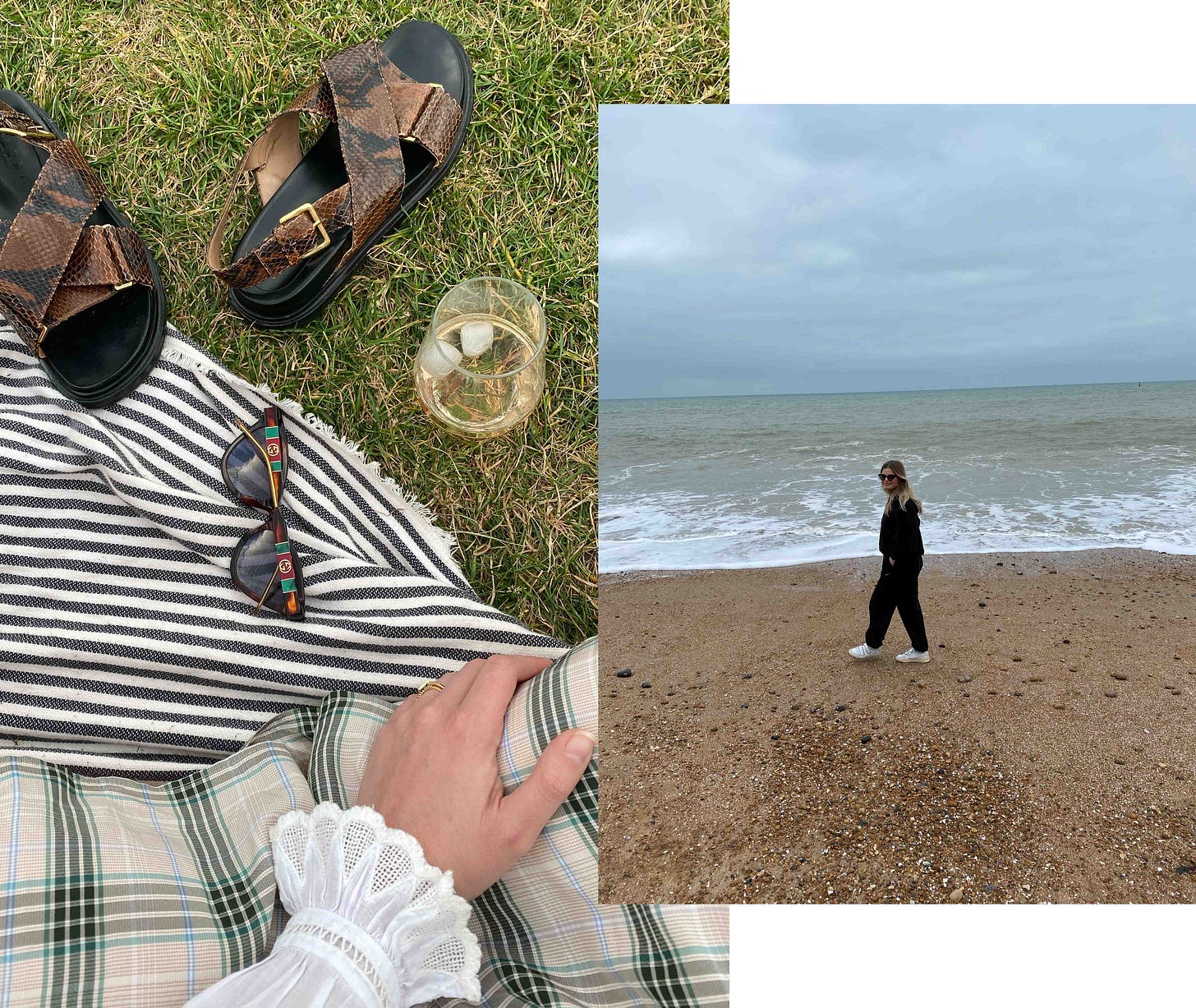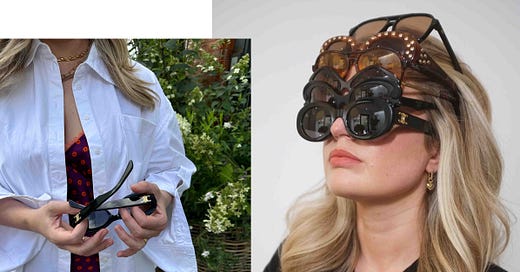I think sunglasses might be the one single accessory that is capable of updating an entire look.
If you were a woman wearing a t-shirt and jeans in the 1970’s, your sunglasses of choice were likely oversized, think Jackie Kennedy. If you wore the equivalent outfit formula in the 1980s, your sunglasses might still be oversized but possibly more colourful. If it was the 1990’s, maybe your glasses got smaller and slightly cat eyed, think Julia Roberts in Notting Hill. You get my point right?. Sometimes it’s not just about the clothes.
With underconsumption-core (exactly what it sounds like - people making it cool to buy less) being a trending conversation on TikTok, I’ve seen a lot of dialogue about how outfit repeating is fundamentally what creates personal style. It’s the consistency of the repetition that makes something uniquely you.
But, I think a lot of us, still don’t want to wear the same look over and over again. I think we’re most guilty of this when it comes to event dressing. The minefield of always wanting to wear something new is a conversation for another time, but what I do want to delve into here, is how much a pair of sunglasses can do the leg work for you - and they don’t even need to be that elaborate or outrageous.
How many pairs?
I don’t know how many pairs I actually currently own because unlike clothes which you easily grow out of, it’s obviously harder to grow out of sunglasses. Trends are cyclical and as an object that is small in size, I figure that this is one category I can afford to hoard.
When I lived in Australia, I wore sunglasses year round. I had a pair that lived in the car, another that lived practically on my head (great if you want to grow out a fringe) or in my handbag and a third specifically for exercise. I, of course now live in the UK. I get my sunglasses out from the depths of a summer handbag sometime in April and then they go back in there begrudgingly sometime in early September and that is that.
But for the time they are out and about, they get a lot of screen time. A full blow out and the layering of prints and/or colour basically makes up my entire personal style, so when it’s too hot for both these things, a nice pair of sunglasses can do a lot.
I mostly rotate between a pair of 2 year old Celine Triomphe Oval’s because they feel like jewellery, and some Gucci cat eyes purchased in 2019. What I love the most about the latter pair is that genuinely they are so comfortable - does that sound weird? I have a big head, comfort in sunglasses is something I have to actually look for, they are often too tight across the bridge.

I don’t need a pair of sunglasses just for exercise so much living in the UK but I do find I need a pair for events/weddings and then another pair for everyday life. The reason these two are the only ones on constant and consistent rotation is that I feel I can wear them with jeans as much as I can dresses. For years, I’d be running out the door for a wedding and just grab whatever sunglasses, only to look back at photos and think it’s weird how I look too dressed up for the beach. Versatility for dress codes is not something we ask of many other accessories is it? You don’t expect to take your everyday handbag to a wedding, do you? But we tend to take the same pair of sunglasses to everything so it’s helpful if they have some flex.
I walked past someone running in these just this morning. I also think they don’t ruin a good dress for a wedding. Just saying.
It is not lost on me that my most worn sunglasses are also very expensive. I know I have expensive taste which often means I like things that are well made. With sunglasses, this isn’t really as relevant - they are all mostly plastic. No one has trademarked type of imprints on plastic quite like they have with saffiano leather (at least not to my knowledge, please correct me if I’m wrong in the comments)… so quality is important but also not that important.
Designer or not designer?
If you’ve never worked in fashion or if you don’t buy and sell stocks, you might not know that there is one business that effectively manufactures, licenses and sells all luxury designer sunglasses - EssilorLuxottica. Yes the same company that produces Michael Kors sunglasses (£100-£200 ballpark) produce Bulgari (£300-£800 ballpark) and Chanel sunglasses (£400-£1300 ballpark).
This monopoly plus the fact that the raw materials to make glasses are very common, means they are incredibly cheap to produce. Unless of course you have a very complicated prescription.
I’d say that it is likely that the marketing spend is a greater than the cost of the raw materials. I can’t find a credible source to give you an exact figure and of course it will vary but it’s high, we’re talking maybe as high as 80-90%. They are, after all, basically just plastic. Remember those plastic chairs you sat on at school? That same plastic (it’s called polypropylene) is the plastic often used in sunglasses, of course sometimes brands use acetate or wire or some other material but whether your glasses were £10 or £1000 the basic materials are mostly the same. Of course, the more expensive the sunglass the more likely the arms will be secured on properly, that they will have a more considered design and that they will come in a nice case.
How much you want to pay for something is deeply personal. I’m just saying that the ‘buy once, buy well’ motto here is not as linked to price as it is for other accessories.
For me, I think it’s about perception, if something costs me more, I’m more likely to look after it well. That logic is so flawed but it’s true, for me at least, and ultimately if I want to create a consistent style. I need to rewear and rewear and rewear. This helps me do that.
Timeless is not the same for everyone
My sunglasses are arguably the most ‘classic’ style choice in my wardrobe’. I don’t believe anything is truly timeless forever but I do ask myself whenever I want something - will I wear this for the next 5 years? I enforce this even more firmly when it comes to sunglasses.
I wear a lot of colour and a lot of print, often at the same time. I choose sunglasses, the same way I choose jewellery. The more classic the better. They have to go with everything. I guess I could change out my sunglasses to match a look everyday but I barely have the headspace to change bags if I need to. Changing sunglasses everyday sounds like a step too far. Plus, when I feel like an outfit is leaning too heavily into the art teacher arena, some classic pieces help keep it in a lane of polish that personally I prefer. These elements are what create the outfit repetition and consistency that is ultimately my personal style. Bright, but considered.
How do you like your sunglasses? Let’s chat in the comments.
Whilst I find my feet on mat leave, this newsletter will remain free. After that, it will likely move mostly to a subscription model. If you’re enjoying this content, you can pledge a subscription here - a little monetary motivation never hurt anyone on statutory maternity pay..
Or you could recommend me to a friend! I’ll love you regardless.






As a sunglasses designer I can fill in some facts for you about the product
Traditionally luxury frames are made from acetate which actually replaced tortoiseshell (think tortoiseshell print) and cellulose (which had issues of setting on fire). It’s ‘natural’ but not biodegradable and even the ‘eco’ versions leave chemical traces. It is more expensive to make an acetate frame than an injected one due to the amount of manufacturing steps. The price will also change depending on where it is made. Japan is the ultimate quality, Italy is also good but the cheapest is made in China. Also the acetate itself comes in different qualities depending on where it was made and how long it takes to cure the acetate, which basically means how long has it been left to sit before making a frame. Overall the frames final production cost can be anything from $20 to $100 depending on factory location, design, material cost and quantity and metal elements.
Injected is used to mass produce designs. But also can allow for more complex shapes or colour's as you are not limited to what a flat slab of acetate. Injected can be biodegradable but again will leave chemical trace. It can also be recycle material but ultimately the product has a reduced perceived value to the customer. The tooling cost for a frame is high but it’s very cheap material costs so the more you make the cheaper it is (think Rayban luxottica).
Lenses also vary in price but any luxury brand would be using lenses with different coatings or developing colours which will increase costs. However, it is illegal to sell sunglasses without uv protection so even your cheap high street frames should have it.
In terms of buying for longevity an acetate frame can always be refitted, rebent, polished and rescrewed. Lenses in most cases can be updated if scratched and any optician should do this. If buying injected always look for something special otherwise don’t bother. With acetate there are plenty of non license brands doing amazing quality if you want design without the labels. And always always look at vintage. The quality of good vintage is incredible and they can be re-bent to fit like new.
Loved reading this article and especially loved hearing the insider info - I like geeking out about this sort of thing too! I work in fashion for a company where the main focus is sustainability, and we often discuss this in terms of accessories. I personally buy new sunglasses about once every 6 years, spending the most I can afford within my budget, with the intention of looking after them - some have been very "on trend" and others very classic in style. The latest brand I purchased has a great sustainability story, where they offer repairs and a take back system at end of life - I think this is a great start to the ongoing issue of over consumption.
Also, now I'm going to get out all my old sunglasses and check over them and see if I can tell how they've been made!😁